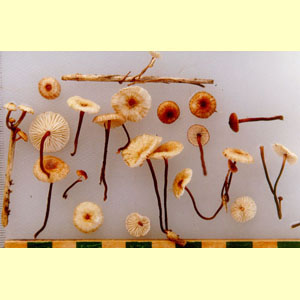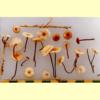
images/Crinipellis/Crinipellis_Sinnott_3567.jpg

Diagnostic characters
Small agaric, growing on the ground or litter (particularly of grasses), with a white spore print. Pileus pale or brown, not viscid, with distinct radial or erect fibrils, which may form scales. Lamellae free, adnexed, adnate or sinuate. Stipe central. Partial veil remnants absent. Spores hyaline, non-amyloid, smooth; germ pore absent. Cheilocystidia present, digitate or diverticulate. Lamellar trama regular. Pileipellis a trichoderm, with very long, thick-walled elements. Clamp connections present.
Similar genera
Crinipellis is distinguished from other small, rather tough agarics with a white spore print, such as Marasmius or Gymnopus, by the dense covering of hair-like fibrils on the pileus surface. The fibrils and the cheilocystidia can be dextrinoid. Chaetocalathus is very similar in microstructure, but a stipe is lacking.
Citation
Crinipellis Pat., J. Bot. (Morot) 3: 336 (1889).
Australian species
One named species: Crinipellis australis (= C. caulicinalis as applied by Australian authors), and very likely to be more species, especially in northern Australia.
Australian distribution
S.A., N.S.W. and Tas. (and probably also W.A., N.T., Qld and Vic.).
Habitat
In native forests.
Substrate
On litter, including grass stems.
Trophic status
Saprotrophic. Some parasitic species are known overseas.
References
Breitenbach, J. & Kränzlin, F. (eds) (1991), Fungi of Switzerland. Volume 3. Boletes and Agarics 1st part. Edition Mykologia, Lucerne. [Illustration, Description and Microcharacters of the non-Australian species C. stipitaria]
Grgurinovic, C.A. (1997a), Larger Fungi of South Australia. The Botanic Gardens of Adelaide and State Herbarium and The Flora and Fauna of South Australia Handbooks Committee, Adelaide. [Description and Microcharacters of C. australis]
Lepp, H. (2007), Some observations on Crinipellis australis, Australas. Mycol. 26: 86–90. [Description of C. australis]
